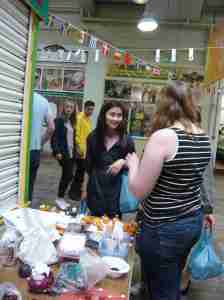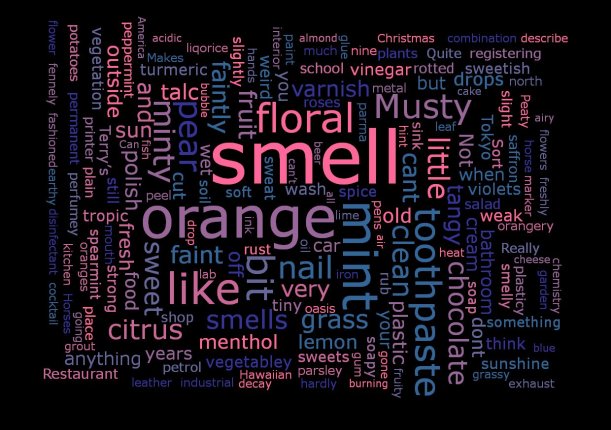

First ideas for a bioLeeds market stall, thought up by Paul Turner, Jo Galloway, Joe
Corcoran and Jo Leng.
“Cell-fies” :-)
…………………..
“We ended up talking a lot about interactive things that involve/use a range of different senses, most of the names need massively improving.
Ideas:
1. Cell-Fies
Images of people’s cells taken using the Hackspace microscope. Use these cells to produce portrait images of the person, or images of Leeds, or other ideas of pictures that might be fun to convert. Collect e-mails from the cell portrait folks and send them the images we create as jpgs or pdfs or whatever. Joe and Paul to optimise the ease of incorporating a cell into an image (e.g. try out on their own pictures, is it easiest to just use a hair or particular colour then make up the rest of the image using ‘stock’ images of cells we already have?). Which cell images and what processing is necessary on the images of people to get this to work well? Video/image storyboard of how to make a microscope for online – could play on a loop at the stall for people that are interested.
2. Genetic Smell of Places
Genetics can alter the way you perceive some smells and flavours (e.g. coriander). A range of things for folks to smell (Paul T to find out some good ones to try so we don’t have to say ‘smell my finger’ or anything like that) and say what they think it smells of. We have stickers that represent the outcomes (e.g. herb or soap shaped) that can be stuck on a big map of Leeds. This way we can collect information about where different smells are from around Leeds. If they’re not from Leeds, they can stick the sticker at the edge of the map nearest to where they’re from. This means that we don’t have to get people to write a load of stuff down if they don’t want to and we can still get an output (the map) from the exercise. We can always hand-draw a big rough map of Leeds if no one can buy one, or stick the pictures in an A to Z that we’ve torn the pages out of or something. Website links to final outcome that can be given out to people on fliers (need to set up and produce fliers/images for fliers, need volunteers?). Options to leave more details if they would like to.
3. Weird Tastes
Molecular Gastronomy? Paul Beales suggested that there could be some good food combinations for people to try, Jo G to contact regarding what this might involve. This could also link to the map records, or some other way of recording outcomes? Acai (miracle) berry and sour tasting things – pictures of people trying different stuff? I’m sure there’s much more that can be done with both of these? Paul T to find out prices for miracle berry powder/tablets and we could have a play with them at some point. Need a volunteer to help develop this. Undyed jam tastes of apricot jam, even if it’s made from strawberries, depending on how red you dye it, people will think it tastes different based on the information from their eyes. Same works with white wine containing red food colouring – because it looks red, people think it tastes like red wine (even connoisseurs can be fooled, but maybe not a trained sommelier.
4. Dancing Sounds
Dancing cornstarch/custard on a speaker http://www.youtube.com/watch?v=sWu9CyDwuFs, http://www.youtube.com/watch?v=GQSG1gym5Jo. Changing the frequency and pitch of the sound played to the non-newtonian fluid alters how it dances about. Could we record soundbites from people to incorporate into a soundtrack that the cornstarch dances to (need a volunteer sound engineer), be good for website/youtube/etc. ‘Name that tune’ based on the motion of the cornstarch on the speaker (need to find a speaker or two and some sound equipment and play around – Joe C and Paul T + others that would like to get messy at some point). We could use differently dyed coloured cornstarch and see how the motion of the music/speech patterns alter the mixing.
Other things we liked but didn’t really think that they fitted, couldn’t get a firm enough idea of what they might involve, or were ‘bio’ enough:
Making dyes – natural dyes and fixing agents can be made in a range of colours:
Blackberries – purple
Carrot leaves – yellow
Coffee – brown
Daffodil blooms – yellow
Dahlia blooms – orange
Elderberry – pale purple
Gorse flowers – yellow
Grass – yellow-green.
Nettles – khaki green
White onion skins – yellow-orange
Red onion skins – mossy green
Red cabbage water – bluey-purple
Rosehips – pinky purple
Teabags – brown
I’m sure you can also make pH indicators using natural things like beetroot that could be developed into some very pretty patterns.
Liquids of different densities form discrete layers if poured carefully – cocktails and such. People could add a layer to a clear container next to the thing they tried/participated in. Make lava lamps using oil and food colouring in bottles.
Salt on blocks of ice. Add colour to show the branching fractal patterns caused by the ice melting – quite slow so could happen over the course of a few hours.
Paint is fun and messy – auto-writing using a pot of paint suspended over some paper and setting it swinging, face paints, hand prints, finger prints, face prints.
I like magnets, I would like to have a go at making a 3D sculpture using some old metal parts from engines that are weird shapes, an electromagnet and lots of magnetic nanoparticles – it could be pretty and make some strange, moving sculptures, but it’s not very biological. Maybe another time with some of the hackspace or other folks.
Self-assembly – people make things at the stall and put the parts together to build a big biological type structure e.g. virus, plankton, chalk, DNA. Can get crochet and knitting patterns for biomolecule structures and cells (we all decided that we couldn’t knit or crochet, but some other folks might be able to). The strength of the sum is greater than the parts – weaving hair/strands together to build something that develops over the course of the morning/day. – This could be quite a good thing to centre the next stall/display/etc around possibly. 3D print large versions of biological nanostructures for people to hold and feel.”
Written up by Jo Galloway

























































